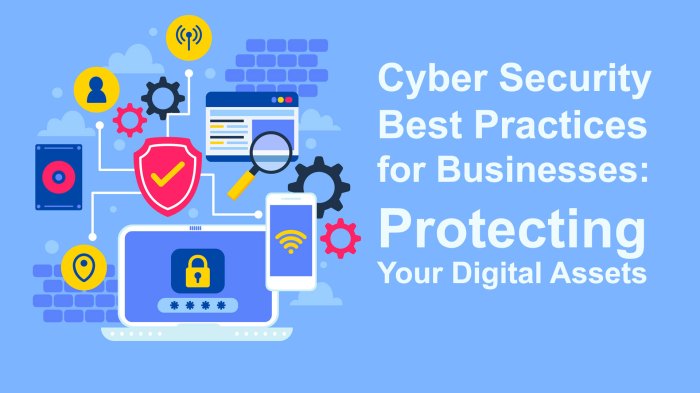
With Protecting Digital Identity: 5 Cybersecurity Best Practices at the forefront, this paragraph opens a window to an amazing start and intrigue, inviting readers to embark on a storytelling journey filled with unexpected twists and insights.
In today's digital age, the protection of our online identities is more crucial than ever. Cybersecurity best practices play a vital role in safeguarding our digital presence from potential threats and attacks. Let's dive into the world of digital identity protection and explore five key practices that can enhance our online security.
Introduction to Cybersecurity Best Practices
Protecting digital identity refers to the measures taken to safeguard an individual's online presence and personal information from unauthorized access or theft. With the increase in online activities and the amount of personal data shared online, it has become crucial to prioritize cybersecurity and implement best practices to prevent identity theft and fraud.
Importance of Cybersecurity in Safeguarding Digital Identities
Cybersecurity plays a vital role in safeguarding digital identities by protecting sensitive information from cyber threats and malicious actors. Without proper cybersecurity measures in place, individuals are at risk of falling victim to various cybercrimes such as phishing, hacking, and identity theft.
Potential Risks to Digital Identities
- Phishing attacks: Cybercriminals use deceptive emails or messages to trick individuals into revealing personal information, such as login credentials or financial details.
- Malware infections: Malicious software can infect devices and steal sensitive data without the user's knowledge, compromising their digital identity.
- Data breaches: Unauthorized access to databases or systems can result in the exposure of personal information, putting individuals at risk of identity theft.
- Social engineering: Manipulative tactics are used to deceive individuals into disclosing confidential information, which can be used to compromise their digital identity.
- Ransomware attacks: Cybercriminals encrypt files on a victim's device and demand ransom in exchange for restoring access, posing a threat to the security of digital identities.
Strong Password Management
Having strong and unique passwords is crucial for protecting your digital identity and sensitive information online. Using weak or common passwords makes it easier for hackers to access your accounts and steal your data.
Importance of Regularly Updating Passwords
- Regularly updating your passwords helps prevent unauthorized access to your accounts, especially if a data breach occurs.
- Changing passwords periodically reduces the risk of someone using previously compromised credentials to hack into your accounts.
- Updating passwords is a proactive measure to enhance the security of your online accounts and personal information.
Techniques for Creating Complex and Secure Passwords
- Use a combination of uppercase and lowercase letters, numbers, and special characters to create a strong password.
- Avoid using easily guessable information such as birthdays, names, or common words.
- Consider using passphrase techniques that involve creating a memorable sentence and using the first letter of each word to form a password.
- Utilize password manager tools to generate and store complex passwords securely.
- Ensure each online account has a unique password to prevent a single breach compromising multiple accounts.
Two-Factor Authentication (2FA)

Two-Factor Authentication (2FA) is a security process that requires users to provide two different authentication factors to verify their identity. This adds an extra layer of security beyond just a password, making it more difficult for unauthorized users to gain access to accounts.
Types of 2FA Methods
- Text Message Codes: Users receive a unique code via SMS to enter along with their password.
- Authentication Apps: Apps like Google Authenticator or Authy generate time-based codes for users to input.
- Biometric Verification: This includes fingerprint scans, facial recognition, or iris scans for authentication.
- Hardware Tokens: Physical devices that generate codes, like YubiKeys, are used as a second factor.
Role of 2FA in Preventing Unauthorized Access
Two-Factor Authentication helps prevent unauthorized access by requiring a second form of verification beyond just a password
This significantly reduces the risk of unauthorized access and enhances overall security.
Phishing Awareness and Prevention
Phishing is a type of cyber attack where malicious actors attempt to deceive individuals into revealing sensitive information such as usernames, passwords, and credit card details. It poses a significant threat to digital identities as it can lead to identity theft, financial loss, and unauthorized access to personal accounts.
Tips for Identifying Phishing Attempts:
- Be cautious of emails or messages requesting urgent action or claiming to be from a trusted organization.
- Check for spelling and grammatical errors in the communication, as these are common in phishing attempts.
- Avoid clicking on links or downloading attachments from unfamiliar or suspicious sources.
- Verify the sender's email address and domain to ensure it matches the legitimate organization.
Common Phishing Techniques:
-
Phishing emails that mimic well-known companies like banks or online retailers to trick recipients into providing personal information.
-
Phishing websites that imitate legitimate sites to steal login credentials or financial information.
-
Social engineering tactics that manipulate individuals into divulging sensitive data through phone calls or messages.
-
Spear phishing, targeting specific individuals with personalized messages to increase the likelihood of success.
Software Updates and Patch Management
Keeping software up to date is crucial for maintaining the security of your digital identity. Software updates and patches often include security fixes that address vulnerabilities that cybercriminals can exploit.Using outdated software poses significant risks to your cybersecurity. These vulnerabilities can be exploited by hackers to gain unauthorized access to your devices, steal sensitive information, or install malware without your knowledge.
Best Practices for Managing Software Updates and Patches
- Enable automatic updates whenever possible to ensure that your software is always up to date with the latest security patches.
- Regularly check for updates manually, especially for software that does not support automatic updates.
- Download software updates and patches only from official sources to avoid downloading malicious software disguised as legitimate updates.
- Keep a record of the software installed on your devices to easily track and manage updates for each program.
- Test software updates in a controlled environment before deploying them to all devices to ensure they do not cause compatibility issues.
Wrap-Up
In conclusion, Protecting Digital Identity: 5 Cybersecurity Best Practices offers a comprehensive approach to securing our online presence. By implementing strong password management, utilizing two-factor authentication, being aware of phishing threats, and staying up to date with software updates, we can significantly reduce the risk of cyber attacks and protect our digital identities.
Let's prioritize cybersecurity to ensure a safe and secure online experience for all.
Answers to Common Questions
How often should I update my passwords?
It's recommended to update your passwords at least every 3-6 months to maintain security.
What is the best way to create a strong password?
Creating a strong password involves using a combination of letters, numbers, and special characters, and avoiding easily guessable information.
Why is two-factor authentication important?
Two-factor authentication adds an extra layer of security by requiring a second form of verification beyond just a password, making it harder for unauthorized users to access your accounts.
How can I identify a phishing attempt?
Phishing attempts often involve emails or messages that try to trick you into revealing personal information or clicking on malicious links. Be cautious of unexpected requests for sensitive data.
What are the risks of using outdated software?
Outdated software can contain vulnerabilities that hackers can exploit to gain unauthorized access to your system or data. Keeping software updated helps patch these vulnerabilities.












